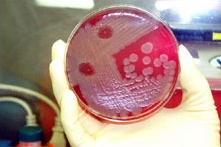Biological agent

A biological agent is an infectious disease that can be used in bioterrorism or biological warfare. There are more than 1200 different kinds of biological agents.
Biological agents include prions, microorganisms (that is viruses, bacteria and fungi) and some unicellular and multicellular eukaryotes (for example parasites) and their associated toxins. They have the ability to adversely affect human health in a variety of ways, ranging from allergic reactions that are usually relatively mild, to serious medical conditions, even death. These organisms are ubiquitous in the natural environment; they are found in water, soil, plants, and animals. Because many biological agents reproduce rapidly and require minimal resources for preservation, they are a potential danger in a wide variety of occupational settings.
Examples of biological agents are anthrax, avian influenza, botulism, foodborne illness, hantavirus, legionnaires' disease, molds and fungi, pneumonic plague, smallpox, tularemia, viral hemorrhagic fevers (VHFs).